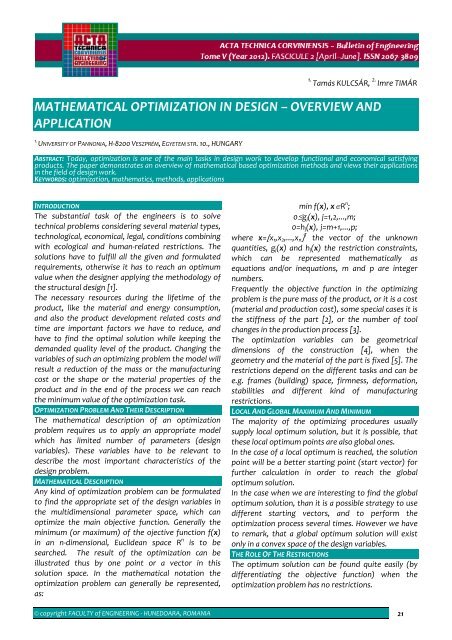Editorial & Advisory Board - Acta Technica Corviniensis
Editorial & Advisory Board - Acta Technica Corviniensis
Editorial & Advisory Board - Acta Technica Corviniensis
Create successful ePaper yourself
Turn your PDF publications into a flip-book with our unique Google optimized e-Paper software.
1.<br />
Tamás KULCSÁR, 2. Imre TIMÁR<br />
MATHEMATICAL OPTIMIZATION IN DESIGN – OVERVIEW AND<br />
APPLICATION<br />
1.<br />
UNIVERSITY OF PANNONIA, H‐8200 VESZPRÉM, EGYETEM STR. 10., HUNGARY<br />
ABSTRACT: Today, optimization is one of the main tasks in design work to develop functional and economical satisfying<br />
products. The paper demonstrates an overview of mathematical based optimization methods and views their applications<br />
in the field of design work.<br />
KEYWORDS: optimization, mathematics, methods, applications<br />
INTRODUCTION<br />
The substantial task of the engineers is to solve<br />
technical problems considering several material types,<br />
technological, economical, legal, conditions combining<br />
with ecological and human‐related restrictions. The<br />
solutions have to fulfill all the given and formulated<br />
requirements, otherwise it has to reach an optimum<br />
value when the designer applying the methodology of<br />
the structural design [1].<br />
The necessary resources during the lifetime of the<br />
product, like the material and energy consumption,<br />
and also the product development related costs and<br />
time are important factors we have to reduce, and<br />
have to find the optimal solution while keeping the<br />
demanded quality level of the product. Changing the<br />
variables of such an optimizing problem the model will<br />
result a reduction of the mass or the manufacturing<br />
cost or the shape or the material properties of the<br />
product and in the end of the process we can reach<br />
the minimum value of the optimization task.<br />
OPTIMIZATION PROBLEM AND THEIR DESCRIPTION<br />
The mathematical description of an optimization<br />
problem requires us to apply an appropriate model<br />
which has limited number of parameters (design<br />
variables). These variables have to be relevant to<br />
describe the most important characteristics of the<br />
design problem.<br />
MATHEMATICAL DESCRIPTION<br />
Any kind of optimization problem can be formulated<br />
to find the appropriate set of the design variables in<br />
the multidimensional parameter space, which can<br />
optimize the main objective function. Generally the<br />
minimum (or maximum) of the ojective function f(x)<br />
in an n‐dimensional, Euclidean space R n is to be<br />
searched. The result of the optimization can be<br />
illustrated thus by one point or a vector in this<br />
solution space. In the mathematical notation the<br />
optimization problem can generally be represented,<br />
as:<br />
min f(x), x∈R n ;<br />
0≤g j (x), j=1,2,...,m;<br />
0=h j (x), j=m+1,...,p;<br />
where x=[x 1 ,x 2 ,...,x T<br />
n ] the vector of the unknown<br />
quantities, g j (x) and h j (x) the restriction constraints,<br />
which can be represented mathematically as<br />
equations and/or inequations, m and p are integer<br />
numbers.<br />
Frequently the objective function in the optimizing<br />
problem is the pure mass of the product, or it is a cost<br />
(material and production cost), some special cases it is<br />
the stiffness of the part [2], or the number of tool<br />
changes in the production process [3].<br />
The optimization variables can be geometrical<br />
dimensions of the construction [4], when the<br />
geometry and the material of the part is fixed [5]. The<br />
restrictions depend on the different tasks and can be<br />
e.g. frames (building) space, firmness, deformation,<br />
stabilities and different kind of manufacturing<br />
restrictions.<br />
LOCAL AND GLOBAL MAXIMUM AND MINIMUM<br />
The majority of the optimizing procedures usually<br />
supply local optimum solution, but it is possible, that<br />
these local optimum points are also global ones.<br />
In the case of a local optimum is reached, the solution<br />
point will be a better starting point (start vector) for<br />
further calculation in order to reach the global<br />
optimum solution.<br />
In the case when we are interesting to find the global<br />
optimum solution, than it is a possible strategy to use<br />
different starting vectors, and to perform the<br />
optimization process several times. However we have<br />
to remark, that a global optimum solution will exist<br />
only in a convex space of the design variables.<br />
THE ROLE OF THE RESTRICTIONS<br />
The optimum solution can be found quite easily (by<br />
differentiating the objective function) when the<br />
optimization problem has no restrictions.<br />
© copyright FACULTY of ENGINEERING ‐ HUNEDOARA, ROMANIA 21

















